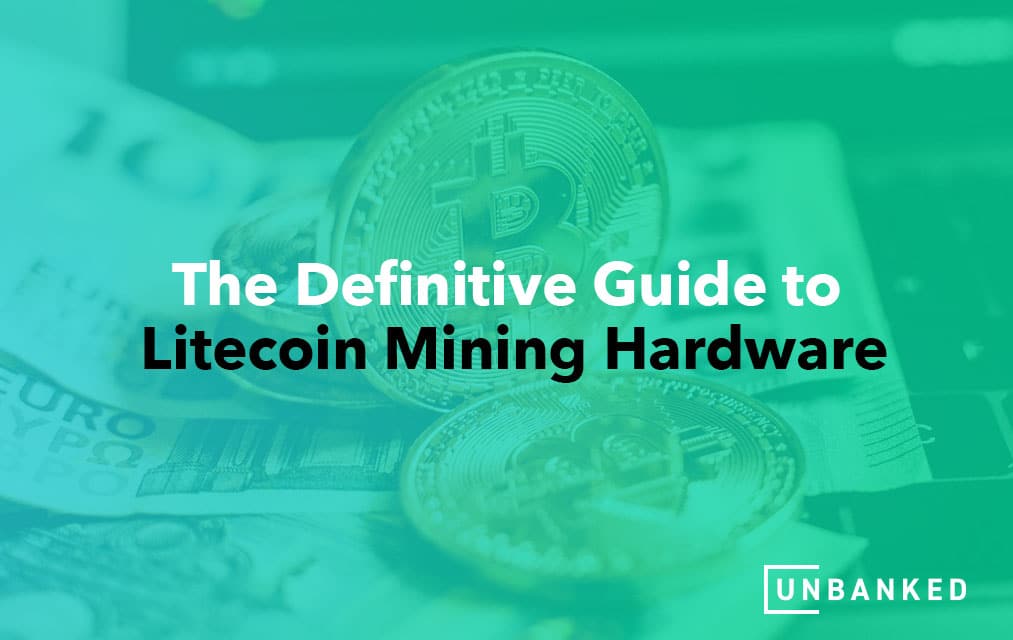Litecoin mining is becoming an increasingly popular alternative to Bitcoin. Due to many technical differences between the two, Litecoin is seen as a more accessible and often more profitable alternative to the crypto giant. As with mining Bitcoin, picking the right pieces of hardware for the job will go a long way in increasing your profit margins and helping you recuperate on your investment.
So whether you’re an experienced miner or just starting to get your feet wet, we’ve put together a definitive guide on Litecoin mining hardware and what you should consider investing in.
Related: Blockchain Expanded: The Ultimate Blockchain Tutorial
What Exactly Is Mining Hardware?
For starters, we need to describe what mining hardware actually is and what the process involves.
If you’re new to cryptocurrency mining, then it’s essential to understand what mining actually involves. The process of mining is mainly using machinery to solve mathematical problems. This “mines” the desired cryptocurrency coin and deposits it in a digital wallet that can then be used in a variety of different ways.
You can even register for services like BlockCard that will make using cryptocurrencies as easy as using a credit card. It’s a little more complicated than a simple explanation, but the vital thing to understand is that the computer hardware you use to mine will significantly affect your chances of mining a coin and earning a profit.
While all cryptocurrencies function similarly (using computer processing power to generate coins and rewarding users), they all have specific differences that make certain types of hardware more effective in the long run. This is why a setup that has been optimized for Bitcoin might not necessarily be the best Litecoin option.
Want to learn more about the bitcoin industry? Check out BlockCard for more information
What Hardware Do You Need to Mine Litecoin?

There are actually three different types of processing units that can be used to mine Litecoins.
For starters, a Central Processing Unit or CPU is the most basic “brain” of a computer that can be used to mine Litecoins. While inexpensive (depending on the model of CPU you have), it’s incredibly slow and doesn’t have enough computing power to be worth the effort. While you can theoretically use your current computer and its CPU to mine Litecoin, you’ll need a more specialized setup to see any noticeable gains.
Next, we have the more powerful Graphics Processing Unit or GPU that is far more powerful. These components are well-known among PC users because of their ability to place modern video games with beautiful graphics. Some GPUs can easily reach into the thousands and take hundreds of watts of power to function at maximum capacity. Not only is a GPU an expensive investment, but running them at full potential can also be costly on your electricity bill. However, they are the most popular type of processing unit when it comes to mining.
Lastly, we have Application-Specific Integrated Circuits or ASICs for short. These are considered to be the premium Litecoin mining hardware because they are created with a single purpose in mind, which is to mine Litecoin.
CPUs and GPUs are fairly powerful and have many uses. However, they’re not designed from the ground up like ASICs are, meaning they will never be as efficient as a powerful ASIC when it comes to mining Litecoin. If you’ve already got a gaming computer with an expensive and powerful GPU, then you’ll see some noticeable returns when mining Litecoin, but if you want to optimize your setup, then you’re going to need to invest in an ASIC.
Related: Everything You Need to Know About How to Sell Bitcoin
Litecoin Mining Hardware to Invest in
CPU and GPU
You probably don’t even need to invest in a CPU or a GPU because they come with the most modernized computers. If you have a gaming laptop or computer, then you will very likely have a powerful GPU that is entirely usable in a mining scenario. However, you need to keep in mind that a GPU is not designed for Litecoin mining and, as a result, will pale in comparison to a dedicated setup. However, if you simply want to try out mining for yourself without investing in anything yet, then using your CPU and GPU can give you an idea of what to expect from Litecoin mining.
Just keep in mind that CPUs and GPUs will need to be continually running to provide the power required to mine Litecoins. This means you can expect your electricity bill to go through the roof.
When it comes to specific CPUs and GPUs, you can take a look at the latest multi-core processors from both Intel and AMD as solid choices. In terms of graphics processing, Nvidia currently takes the lead with its RTX series graphics card, offering an incredible amount of performance, albeit at a dazzling price tag. However, if you’re looking for an all-in-one machine that can be used for demanding tasks and Litecoin mining alike, then these hardware choices are a good option.
Can You GPU Mine Litecoin?
On its own, GPU cannot mine Litecoin because it isn’t as powerful as ASICs hardware. But you can use GPU in conjunction with your ASIC rig to boost your processing power.
Need a card to use your crypto without delay? Check out what BlockCard can do for you
ASICS
If you’re serious about mining Litecoin, then the smartest hardware to invest in is an ASCI. Here are a few of the best ASICS Litecoin mining hardware options:
Antminer Series
These are well-known in the cryptocurrency mining scene and have been around since 2017. These devices are primarily made for the sake of mining cryptocurrency and, as a result, can’t actually do much. You can’t use them as regular computers, and you’ll need to connect them to an existing device to configure them and get them set up.
Thankfully, these can be extremely cost-effective when it comes to mining Litecoins, and you can pick them up for relatively low prices if you’re okay buying second-hand or refurbished. There are many different makes and models in the ASIC world, so we highly suggest you do some research on the latest models to find the most cost-effective solution in terms of processing capabilities and power consumption.
FutureBit Apollo LTC Pod
The FutureBit Apollo LTC Pod is another capable Litecoin mining rig that can handle 120 MH/s. You can find an LTC Pod for about $375. This is a higher price tag than Antminer, but it has a maximum power draw of 200 watts, which is a sixth of the power draw of the Antminer. If you have high electricity costs in your area, you may want to consider an LTC Pod.
Another benefit of the LTC Pod is that it doesn’t generate as much heat or noise as a traditional ASIC. Traditional ASIC hardware can be as loud and hot as a hairdryer. You could run the LTC Pod in your office and not be annoyed. Note: FutureBit has popular models that sell out often.
FutureBit Moonlander 2
The Moonlander is one of the cheapest mining hardware solutions that sell for about $65. The Moonlander is a low-cost USB miner with a hashrate of 5 MH/s with under 10 watts of power. A great beginner’s rig, the Moonlander can run on Windows, Mac, or Linux with a USB port.
Related: Bitcoin vs. Bitcoin Cash: What’s the Difference?
Why LiteCoin Hashrates Matter
The current hashrate for Litecoin is about around 300 TH/s. This is important because Litecoin uses a proof-of-work method to manage the blockchain and verify transactions. Miners are rewarded for solving the hash from each transaction.
The hashrate determines how many miners are managing the network. And because the hashrate often follows the cryptocurrency’s price, the higher the price means more miners will be managing the blockchain.
Want expert insights on investing in blockchain technologies? Check out our latest headlines on the future of cryptocurrency investments.
How Long Does it Take to Mine One Litecoin?
To mine one Litecoin, it can take about 45 days using state-of-the-art, powerful mining hardware. The proper rig can commit the Litecoin block to the blockchain in less than three minutes.
Mining an entire block is challenging and can take longer, depending on the block’s difficulty. But a mined block pays off big because it releases 25 Litecoin.
What is the Best Litecoin Mining Rig?
The ASIC Antminer L3+ is the best rig for mining because it has 288 BM1485 chips designed specifically for mining Scrypt coins. It also is more powerful than other hardware, making it better at solving the hash. It has a maximum hashrate of 504 MH/s and 800-watt power consumption.
Is Litecoin Mining Profitable in 2022?
Whether mining Litecoin is profitable is completely dependent on the expense of your barrier to entry. For those that already have the hardware, you’ll only need to worry about energy costs. If you have a substantial rig already, then mining Litecoin will be profitable in 2022.
If you need to purchase mining hardware, then you’ll really need to research which hardware will be the most profitable based on current hashrates, energy costs, and the probability of solving the hash. Doing this homework will help you create a budget that will make your mining profitable.
Looking for alternative investment opportunities? Find out how cryptocurrency may be a wise investment for the future.
Related Link: 10 Reasons to Consider Going Unbanked
Litecoin Mining Difficulty
The problem with mining Litecoin now is that you’ll need several ASICs rigs with GPUs connected to solve the hash before other miners. Otherwise, you’ll need to join a mining pool or use a cloud-based mining solution to have any shot at mining Litecoin.
Joining a Litecoin Mining Pool
By joining a Litecoin mining pool, you’ll have a higher probability of solving the hash and earning Litecoin tokens. But you’ll need to research the different Litecoin mining pools to determine which is a better fit for you and your budget.
When selecting a mining pool, you’ll want to assess:
- The fees for being in the pool
- The minimum payout level
- Geographic location of the pool servers for better performance
Some of the best mining pools in the United States:
- LitecoinPool.org: The oldest and largest pay-per-share (PPS) pool.
- viaBTC: This PPS pool mines several cryptocurrencies, including Bitcoin, Ethereum, Dash, and Zcash. It also offers cloud mining.
- ProHashing: Using the PPS payment model, ProHashing doesn’t have payout fees or transaction fees. Uses a flat fee model of 4.99%.
Cloud-based Litecoin Mining
A cloud-based mining solution allows you to lease mining hardware and software without buying your own rig. These cloud-based companies have farms of mining hardware that they lease to individuals for a monthly fee.
Cloud-based solutions are easy because you’re buying the service vs. the hardware. You don’t need to worry about maintenance because the host handles the rigs. When selecting a host, you’ll want to research their fees and payouts to see if it is lucrative.
Want sound financial advice and tips? Learn how Unbanked can help you diversify and grow your investments.
Related Link: Cryptocurrencies as a Solution for the Unbanked
Should You Invest in Litecoin Mining?

If you’ve never tried to mine a cryptocurrency or have no experience in the subject, then it’s going to take some time before you can fully understand the ins and outs of Litecoin mining. Luckily, there are plenty of resources available to help you learn more about Litecoin mining and cryptocurrencies in general. This advice will significantly increase your chances of success if you decide to invest in Litecoin mining.
Since it’s something you can do with standard consumer-grade computer hardware, it’s worth experimenting with the device if you’re new to the concept. However, if you’re trying to push the limits of your hardware and are heavily invested in cryptocurrency mining, then we hope that this guide can help you make smarter hardware decisions.
BlockCard makes it easy and convenient to use your cryptocurrency
Want to learn how cryptocurrency can open more banking opportunities? Read the latest on cryptocurrency banking strategies and trends.
Related Link: 5 Common Benefits that Blockchain Has on Financial Services





